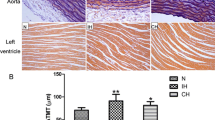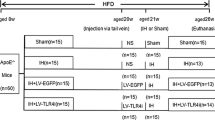Abstract
Objectives
To develop an intermittent hypoxia/reoxygenation (IH/ROX) rabbit carotid artery model and then investigate the inflammation status of rabbit carotid artery endothelium after IH exposure and its relationship with leptin.
Materials and methods
After anesthetization, rabbit’s right common carotid artery was cleared of surrounding tissue with anatomic microscope, cannulated to its distal part and the proximal part was ligated. Preparations were challenged by changing the PO2 of the gas mixture equilibrating the perfusate. Alternate perfusing (2 mL/min) of equilibrated perfusate bubbled with normoxia or hypoxia gas mixtures formed IH/ROX cycles in the right carotid common artery, simulating the pattern of hypoxic episodes seen in obstructive sleep apnea (OSA), or continuous perfusing of hypoxia perfusate to form continuous hypoxia (CH) modes. Sixty adult male New Zealand White rabbits (2.5–3.0 kg) were separated into six groups, ten per group. Groups were: A, intermittent normoxia (IN) group, perfused with perfusion equilibrated with 21% O2 [PO2 about 141 ± 2.87 mmHg] for 15 s and 21% O2 for 1 min 45 s, 60 cycles; B, severe IH group, 5% O2 [PO2 about 35.2 ± 1.27 mmHg] 15 s and 21% O2 1 min 45 s, 60 cycles; C, mild IH group, 10% O2 [PO2 about 54.3 ± 3.31 mmHg] 15 s and 21% O2 1 min 45 s, 60 cycles; D, severe IH+Lep group, protocol was the same with severe IH group; E, CH group, IN for 1 h 45 min and then 5% O2 for 15 min; and F, Lep group, the same with IN group. Right common carotid artery parts distal to the cannula were harvested after exposure, and endothelial cell layers were gotten from longitudinal outspread vessels. Nuclear factor κB (NFκB) DNA binding activities of partial cell layers were measured with electrophoretic mobility shift assay in the IN group, severe IH group, mild IH group, and CH group nuclear extracts. The other part of the cell layers in the IN group, severe IH group, severe IH+Lep group, and Lep group were cultured for 2 h, and during the culture procedure, recombinated human leptin solutions were added to culture dishes of severe IH+Lep group and Lep group (resulted concentration, 10 ng/mL). Enzyme-linked immunosorbent assay was used to analyze medium interleukin-6 (IL-6) concentrations, reverse transcription polymerase chain reaction was used to analyze endothelial cell Ras homology A (RhoA) mRNA expression levels. Statistical analysis was done with SPSS 11.5 software package.
Results
NFκB DNA binding activities were significantly different between groups (F = 112.428, P < 0.001). This activity in the severe IH group (4.27 ± 0.64) was higher than that in the mild IH group (2.33 ± 0.45, P < 0.001), IN group (1.00 ± 0.26, P < 0.001), and CH group (1.15 ± 0.36, P < 0.001). RhoA mRNA expression levels were different in groups (F = 26.634, P < 0.001).This level in the severe IH+Lep group (2.54 ± 0.53) was higher than that in the severe IH group (1.57 ± 0.44, P = 0.002), IN group (1.00 ± 0.31, P < 0.001), and Lep group (1.31 ± 0.30, P < 0.001). IL-6 concentrations were different in groups (F = 79.922, P < 0.001). IL-6 concentration in the severe IH+Lep group (1591.50 ± 179.57 pg/mL) was higher than that in the severe IH group (1217.20 ± 320.62 pg/mL, P = 0.036), IN group (325.40 ± 85.26 pg/mL, P < 0.001), and Lep group (517.40 ± 183.09 pg/mL, P < 0.001).
Conclusions
IH/ROX activated the inflammation pathway significantly in the endothelium, which was more intensive than CH and intensity-dependent. When exposed to both IH/ROX and leptin, inflammation occurs more dramatically. It means that synergic activating roles were performed by IH/ROX and leptin. This study may have a clinical implication that IH can cause endothelial damage through activated inflammation in OSA patients, and if the OSA patients have obesity at the same time, the endothelial damage or the inflammation would be more significant because of elevated leptin level as a synergic factor.




Similar content being viewed by others
References
McNicholas WT, Bonsignore MR, Management Committee of EU COST ACTION B26 (2007) Sleep apnoea as an independent risk factor for cardiovascular disease: current evidence, basic mechanisms and research priorities. Eur Respir J 29:156–178
Feng J, Chen BY, Guo MN, Cao J, Zhao HY, Liang DC, Zuo AJ (2007) Interleukin-6 and tumor necrosis factor-alpha levels of endothelial cells in different hypoxia modes: in vitro experiment. Zhonghua Yi Xue Za Zhi 87:774–777
Feng J, Chen BY, Guo MN, Cao J, Zhao HY, Liang DC, Zuo AJ (2007) Changes of nuclear factor-kappaB and intercellular adhesion molecule-1 in endothelial cells exposed to various intermittent hypoxia. Zhonghua Jie He He Hu Xi Za Zhi 30:202–206
Shamsuzzaman AS, Gersh BJ, Somers VK (2003) Obstructive sleep apnea: implications for cardiac and vascular disease. JAMA 290:1906–1914
Punjabi NM, Polotsky VY (2005) Disorders of glucose metabolism in sleep apnea. J Appl Physiol 99:1998–2007
Vgontzas AN, Tan TL, Bixler EO, Martin LF, Shubert D, Kales A (1994) Sleep apnea and sleep disruption in obese patients. Arch Intern Med 154:1705–1711
Peppard PE, Young T, Palta M, Dempsey J, Skatrud J (2000) Longitudinal study of moderate weight change and sleep-disordered breathing. JAMA 284:3015–3021
Newman AB, Foster G, Givelber R, Nieto FJ, Redline S, Young T (2005) Progression and regression of sleep-disordered breathing with changes in weight: the Sleep Heart Health Study. Arch Intern Med 165:2408–2413
Tishler PV, Larkin EK, Schluchter MD, Redline S (2003) Incidence of sleep-disordered breathing in an urban adult population: the relative importance of risk factors in the development of sleep-disordered breathing. JAMA 289:2230–2237
Fritscher LG, Mottin CC, Canani S, Chatkin JM (2007) Obesity and obstructive sleep apnea–hypopnea syndrome: the impact of bariatric surgery. Obes Surg 17:95–99
Grunstein RR, Stenlöf K, Hedner JA, Peltonen M, Karason K, Sjöström L (2007) Two year reduction in sleep apnea symptoms and associated diabetes incidence after weight loss in severe obesity. Sleep 30:703–710
Münzberg H, Björnholm M, Bates SH, Myers MG Jr (2005) Leptin receptor action and mechanisms of leptin resistance. Cell Mol Life Sci 62:642–652
Cinaz P, Bideci A, Camurdan MO, Güven A, Gönen S (2005) Leptin and soluble leptin receptor levels in obese children in fasting and satiety states. J Pediatr Endocrinol Metab 18:303–307
Fouillioux C, Contreras F, Lares M, Cano R, Leal E, Arraiz N, Bermúdez V, Velasco M (2008) Metabolic and hemodynamic markers of endothelial dysfunction in patients with hypertension and patients with type 2 diabetes during the cold pressor test. Am J Ther 15:389–396
Kim K, Valentine RJ, Shin Y, Gong K (2008) Associations of visceral adiposity and exercise participation with C-reactive protein, insulin resistance, and endothelial dysfunction in Korean healthy adults. Metabolism 57:1181–1189
Grosfeld A, Andre J, Hauguel-De Mouzon S, Berra E, Pouyssegur J, Guerre-Millo M (2002) Hypoxia-inducible factor transactivates the human leptin gene promoter. J Biol Chem 277:42953–42957
Meissner U, Hänisch C, Ostreicher I, Knerr I, Hofbauer KH, Blum WF, Allabauer I, Rascher W, Dötsch J (2005) Differential regulation of leptin synthesis in rats during short-term hypoxia and short-term carbon monoxide inhalation. Endocrinology 146:215–220
Cummings KJ, Wilson RJ (2005) Time-dependent modulation of carotid body afferent activity during and after intermittent hypoxia. Am J Physiol Regul Integr Comp Physiol 288:R1571–R1580
Etienne-Manneville S, Hall A (2002) Rho GTPase in cell biology. Nature 420:629–635
Yamauchi M, Tamaki S, Tomoda K, Yoshikawa M, Fukuoka A, Makinodan K, Koyama N, Suzuki T, Kimura H (2006) Evidence for activation of nuclear factor kappaB in obstructive sleep apnea. Sleep Breath 10:189–193
Williams A, Scharf SM (2007) Obstructive sleep apnea, cardiovascular disease, and inflammation—is NF-kappaB the key? Sleep Breath 11:69–76
Greenberg H, Ye X, Wilson D, Htoo AK, Hendersen T, Liu SF (2006) Chronic intermittent hypoxia activates nuclear factor-kappaB in cardiovascular tissues in vivo. Biochem Biophys Res Commun 343:591–596
Lentsch AB, Ward PA (2000) The NFkappaBb/IkappaB system in acute inflammation. Arch Immunol Ther Exp (Warsz) 48:59–63
Savransky V, Nanayakkara A, Vivero A, Li J, Bevans S, Smith PL, Torbenson MS, Polotsky VY (2007) Chronic intermittent hypoxia predisposes to liver injury. Hepatology 45:1007–1013
Schofield CJ, Ratcliffe PJ (2004) Oxygen sensing by HIF hydroxylases. Nat Rev Mol Cell Biol 5:343–354
Matarese G, Mantzoros C, La Cava A (2007) Leptin and adipocytokines: bridging the gap between immunity and atherosclerosis. Curr Pharm Des 13:3676–3680
Wójciak-Stothard B, Potempa S, Eichholtz T, Ridley AJ (2001) Rho and Rac but not Cdc42 regulate endothelial cell permeability. J Cell Sci 114:1343–1355
Liu HW, Halayko AJ, Fernandes DJ, Harmon GS, McCauley JA, Kocieniewski P, McConville J, Fu Y, Forsythe SM, Kogut P, Bellam S, Dowell M, Churchill J, Lesso H, Kassiri K, Mitchell RW, Hershenson MB, Camoretti-Mercado B, Solway J (2003) The RhoA/Rho kinase pathway regulates nuclear localization of serum response factor. Am J Respir Cell Mol Biol 29:39–47
Wettschureck N, Offermanns S (2002) Rho/Rho kinase mediated signaling in physiology and pathophysiology. J Mol Med 80:629–638
Bishop AL, Hall A (2000) Rho GTPases and their effector proteins. Biochem J 348(Pt 2):241–255
Acknowledgements
This study was supported by grants from the National Natural Science Foundation of China (no. 30800507).
Author information
Authors and Affiliations
Corresponding author
Rights and permissions
About this article
Cite this article
Feng, J., Chen, By., Cui, Ly. et al. Inflammation status of rabbit carotid artery model endothelium during intermittent hypoxia exposure and its relationship with leptin. Sleep Breath 13, 277–283 (2009). https://doi.org/10.1007/s11325-009-0246-6
Received:
Revised:
Accepted:
Published:
Issue Date:
DOI: https://doi.org/10.1007/s11325-009-0246-6




